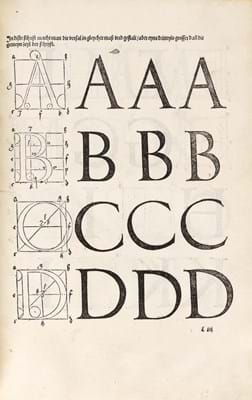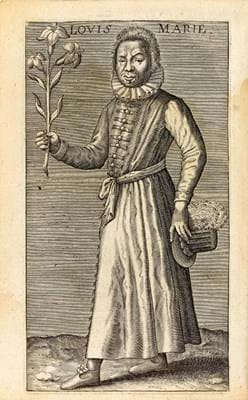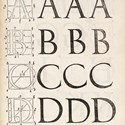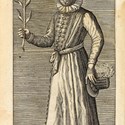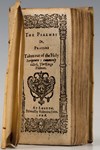A number of other early printed works carrying five, even six-figure figure estimates were left unsold, but taken to $140,000 (£104,475) – a little under the low estimate – was a sammelband containing three famous works written, illustrated and indeed designed by Albrecht Dürer towards the end of his life.
Together, wrote the editors of Printing and the Mind of Man, those works represent the “…foundation of accepted aesthetic dogma until the nineteenth century”.
Made to measure
The first to be issued from Hieronymous A Formschneider’s Nuremburg press, in 1525, and still the most famous and influential, was Underweysung der Messung…
A treatise on mensuration, it introduced to a German and wider European audience the techniques of perspective and mathematical proportion in drawing, painting, architecture and letter forms that Dürer had learned in Italy.
Except for the Geometria Deutsch of c.1486-87, a book of arithmetical rules for builders that Dürer knew and used, it was also the first mathematical textbook published in Germany.
Two years later came a treatise on fortification, and then, in 1528, a work on the proportion of the human body that, following Dürer’s death earlier that year, was edited and seen through the press for his widow by Willibald Perckheimer.
There they were rapturously welcomed and even baptised at court – but in at least three instances quickly succumbed to European diseases, against which they had no natural immunity. One of their number, looking uncomfortable in his European clothes, is depicted above.
Bound together as a single volume in blind tooled vellum of the period, this set was once owned by the English architect and leading Arts & Crafts designer, Charles Robert Ashbee.
Claude d’Abbeville’s Histoire de la mission des peres capucins en l’isle de Maragnan…, published in Paris in 1614, is one of the earlier and more important works on the European colonisation of the country we now know as Brazil.
In a contemporary vellum binding, a second impression copy was sold in New York for $25,000 (£18,655).
According to the authors of a 1960s edition, there may be as few as 10 extant copies of the original, and auction records of the last 45 years reveal only one other.
Described as a second edition of 1614, it sold for $32,500 at Sotheby’s New York in 2007.
Cooking up a tale

The 19th century German playbill for a dramatic re-imagining of Captain Cook’s Tahitian experiences. Sold for $5000 (£3730) by Bonhams New York.
Across Europe, many historical dramas based on the travels and exploits of Captain Cook were made for the stage, “most of them unconstrained by historical fact”, according to the US cataloguer, and one such is illustrated above.
Sold for $5000 (£3730), this woodcut illustrated German playbill dates from c.1840 and promises a lively account of his experiences in Tahiti, in which locals form a human pyramid, a battle between British sailors and the islanders is enacted and Cook is tortured by the Tahitian king.
This …Pantomime mit Märschen, Pyramiden und Evolutionen also contained, it seems, an episode in which Cook sells the Tahitian queen into slavery.


